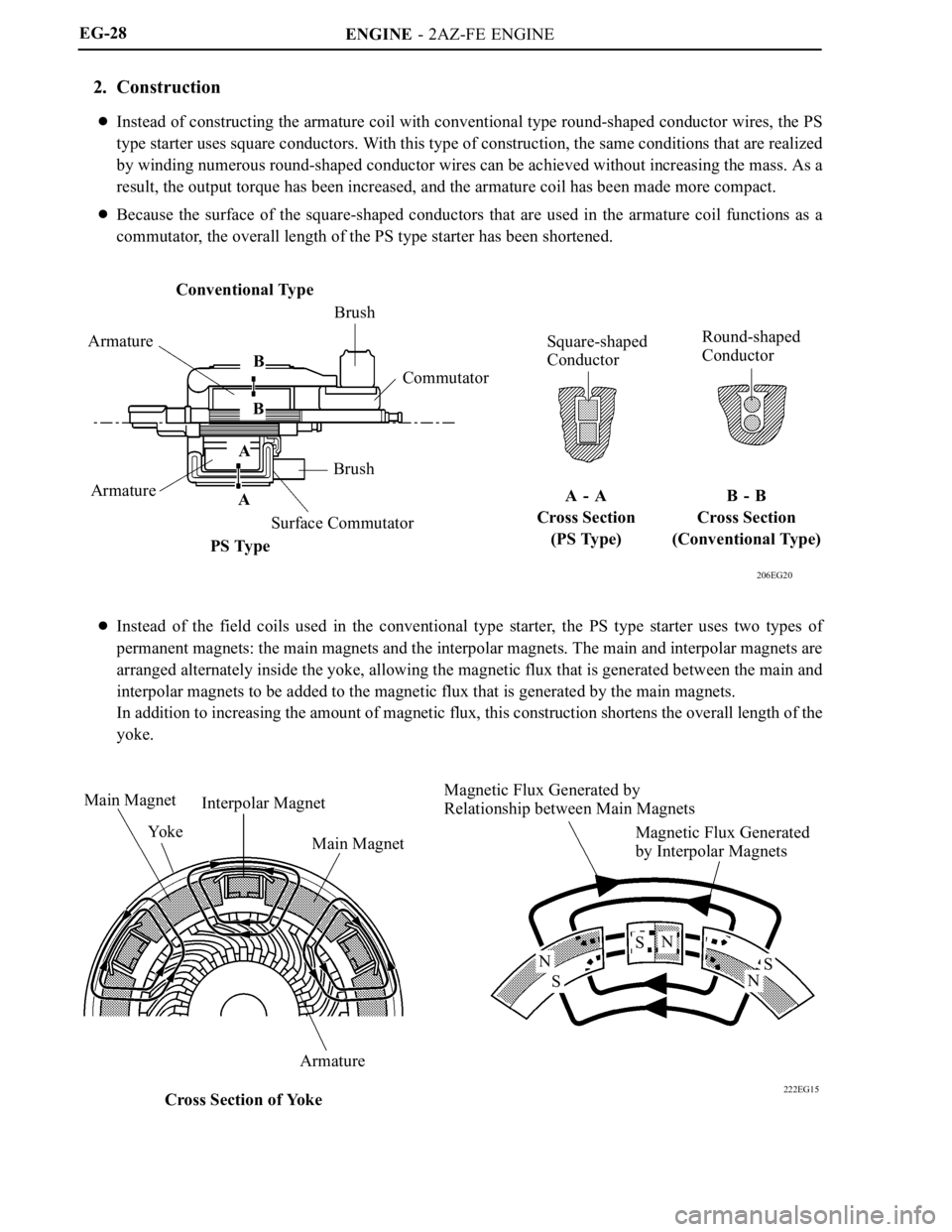Page 5 of 2000
ENGINE - 2AZ-FE ENGINE
01NEG27Y
Irregularly shaped
outer casting
surface of linerCylinder Block
Liner A
A
A - A Cross Section
01NEG28Y
Water Jacket
Spacer Water Jacket
A - A Cross Section A
A EG-8
The liners are the spiny-type, which have been manufactured so that their casting exteriors form large
irregular surfaces in order to enhance the adhesion between the liners and the aluminum cylinder block.
The enhanced adhesion helps heat dissipation, resulting in a lower overall temperature and heat
deformation of the cylinder bores.
Water jacket spacers are provided in the water jacket of the cylinder block.
They suppress the water flow in the center of the water jackets, guide the coolant above and below the
cylinder bores, and ensure uniform temperature distribution. As a result, the viscosity of the engine oil that
acts as a lubricant between the bore walls and the pistons can be lowered, thus reducing friction.
Page 10 of 2000

ENGINE - 2AZ-FE ENGINE
181EG11
VVT-i ControllerIntake CamshaftTiming Rotor
Exhaust Camshaft
Timing Sprocket
185EG25 181EG14
Cam Spring
Cam
Plunger
SpringChain
Te n s i o n e r
Chain Damper
Oil Jet
Chain TensionerChain SlipperEG-13
2. Camshaft
The intake camshaft is provided with timing rotor to trigger the camshaft position sensor.
In conjunction with the adoption of the VVT-i system, an oil passage is provided in the intake camshaft
in order to supply engine oil pressure to the VVT-i system.
A VVT-i controller has been installed on the front of the intake camshaft to vary the timing of the intake
valves.
3. Timing Chain
A roller chain with an 8 mm (0.315 in.) pitch is used to make the engine more compact.
The timing chain is lubricated by an oil jet.
The chain tensioner uses a spring and oil pressure to maintain proper chain tension at all times.
The chain tensioner suppresses noise generated by the timing chain.
A ratchet type non-return mechanism is used.
To achieve excellent serviceability, the chain tensioner is constructed so that it can be removed and
installed from the outside of the timing chain cover.
Page 11 of 2000
ENGINE - 2AZ-FE ENGINE
208EG07
VVT-i Controller
Camshaft Timing
Oil Control Valve
Oil Return
Hole
Oil PumpOil Filter Chain
Te n s i o n e r
01NEG33Y
Bypass
Va l v e
Relief
Va l v eMain Oil Hole
Oil Filter
Oil Pump
Oil StrainerChain
Te n s i o n e rCylinder Head
Exhaust
Camshaft
Journal
Oil Control
Va l v e
VVT-i Controller
Oil Pan
Intake
Camshaft
Journal
Crankshaft
Journal
Crankshaft
Pin
Oil Jet
Piston
Cylinder
Block
Barance
Shaft
Timing
Chain EG-14
LUBRICATION SYSTEM
1. General
The lubrication circuit is fully pressurized and oil passes through an oil filter.
The trochoid gear type oil pump is chain-driven by the crankshaft.
The oil filter is attached downward from the crankcase to improve serviceability.
Along with the adoption of the VVT-i system, the cylinder head is provided with a VVT-i controller and
a camshaft timing oil control valve. This system is operated by the engine oil.
Oil Circuit
Page 23 of 2000
ENGINE - 2AZ-FE ENGINE
01NEG45Y
RegulatorB
M
IG
RLO
L
Ignition Switch
To Discharge
Wa r n i n g L i g h t
Generator
ECM
281EG13
281EG12
Coil SpringPulley
Helical Coil Type One-way Clutch EG-26
Wiring Diagram
2. Generator Pulley
A helical coil type one-way clutch is used on the generator pulley in order to reduce the load that acts on
the auxiliary equipment belt.
The pulley mounting nut and the generator pulley have been integrated to achieve a compact construction.
Page 24 of 2000

ENGINE - 2AZ-FE ENGINE
01NEG46Y
ArmatureSurface Commutator
Permanent Magnet
Brush
LengthEG-27
STARTING SYSTEM
1. General
A compact and lightweight PS (Planetary reduction-Segment conductor motor) type starter is used.
Because the PS type starter contains an armature that uses square-shaped conductors, and its surface
functions as a commutator, it has resulted in both improving its output torque and reducing its overall
length.
In place of the field coil used in the conventional type starter, the PS type starter uses two types of
permanent magnets: main magnets and interpolar magnets. The main magnets and interpolar magnets
have been efficiently arranged to increase the magnetic flux and to shorten the length of the yoke.
Specifications
Starter TypePS Type
Rating Output1.7 kW
Rating Voltage12 V
Length*1mm (in.)128 (5.04)
Weight g (lb)2950 (6.50)
Rotational Direction*2Counterclockwise
*1: Length from the mounted area to the rear end of the starter
*
2: Viewed from pinion side
Page 25 of 2000

ENGINE - 2AZ-FE ENGINE
206EG20
Conventional Type
A - A
Cross Section
(PS Type)B - B
Cross Section
(Conventional Type)
B
B
A
A Armature
ArmatureBrushCommutator Brush
Surface CommutatorSquare-shaped
ConductorRound-shaped
Conductor
PS Type
222EG15
Main Magnet
Interpolar Magnet
Yo k e
Main Magnet
Armature
Cross Section of YokeMagnetic Flux Generated by
Relationship between Main Magnets
Magnetic Flux Generated
by Interpolar Magnets
N
N
N
S
S
S EG-28
2. Construction
Instead of constructing the armature coil with conventional type round-shaped conductor wires, the PS
type starter uses square conductors. With this type of construction, the same conditions that are realized
by winding numerous round-shaped conductor wires can be achieved without increasing the mass. As a
result, the output torque has been increased, and the armature coil has been made more compact.
Because the surface of the square-shaped conductors that are used in the armature coil functions as a
commutator, the overall length of the PS type starter has been shortened.
Instead of the field coils used in the conventional type starter, the PS type starter uses two types of
permanent magnets: the main magnets and the interpolar magnets. The main and interpolar magnets are
arranged alternately inside the yoke, allowing the magnetic flux that is generated between the main and
interpolar magnets to be added to the magnetic flux that is generated by the main magnets.
In addition to increasing the amount of magnetic flux, this construction shortens the overall length of the
yoke.
Page 33 of 2000
ENGINE - 2AZ-FE ENGINE EG-36
5. Main Components of Engine Control System
General
The main components of the 2AZ-FE engine control system are as follows:
Component
OutlineQuantity
ECM32-bit CPU1
Mass Air Flow MeterHot-wire Type1
Crankshaft Position Sensor (Rotor Teeth)Pick-up Coil Type (36-2)1
Camshaft Position Sensor (Rotor Teeth)Pick-up Coil Type (3)1
Throttle Position SensorNon-contact Type1
Accelerator Pedal Position SensorNon-contact Type1
Knock SensorBuilt-in Piezoelectric Element Type
(Flat Type)1
Air-fuel Ratio Sensor
(Bank 1, Sensor 1)Type with Heater
(Planar Type)1
Heated Oxygen Sensor
(Bank 1, Sensor 2)Type with Heater
(Cup Type)1
Injector12-hole Type4
ECM
The 32-bit CPU of the ECM is used to increase the speed for processing the signals.
Page 66 of 2000

ENGINE - 2AZ-FE ENGINE
01MEG02Y
Valve Timing : Intake Valve Opening Angle
: Exhaust Valve Opening Angle
VVT-i Operation
Range
VVT-i Operation
RangeTDC
3
3
43
65
25
45
BDCEG-3
Engine Specifications
No. of Cyls. & Arrangement4-cylinder, In-line
Valve Mechanism16-valve DOHC, Chain Drive (with VVT-i)
Combustion ChamberPentroof Type
ManifoldsCross-flow
Fuel SystemSFI
Ignition SystemDIS
Displacement cm3 (cu. in.)2362 (144.1)
Bore x Stroke mm (in.)88.5 x 96.0 (3.48 x 3.78)
Compression Ratio9.8 : 1
Max. Output*1(SAE-NET)124 kW @ 6000 rpm (166 HP @ 6000 rpm)
Max. Torque*1(SAE-NET)224 N.m @ 4000 rpm (165 ft-lbf @ 4000 rpm)
IntakeOpen3 - 43 BTDC
Valve Timing
IntakeClose65 - 25 ABDCVa l v e T i m i n g
ExhaustOpen45 BBDCExhaustClose3 ATDC
Firing Order1 - 3 - 4 - 2
Research Octane Number91 or higher
Octane Rating87 or higher
Oil GradeILSAC
Tailpipe Emission RegulationULEV-II, SFTP
Evaporative Emission RegulationLEV-II, ORVR
Engine Service Mass*2 (Reference) kg (lb)138 (304.2)
*1: Maximum output and torque rating is determined by revised SAE J1349 standard.
*
2: Weight shows the figure with oil and water fully filled.